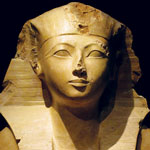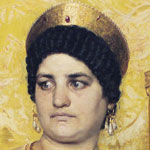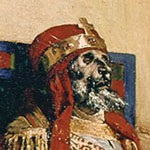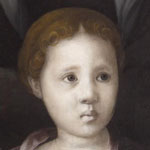 |
Name | Amalek, Negev Desert warlord |
| Lived | c. 1800 bc–c. 1725 bc | |
| Offense | The descendants of Amalek formed a warlike tribe that betrayed the Israelites on their flight from Egypt to the Holy Land, slaughtering and mutilating children and the elderly. | |
| Punishment | “You shall blot out the memory of Amalek from under the sky,” Moses promised the Israelites in Deuteronomy; “you shall not forget.” | |
| Afterlife | “Do you know how my father would try out a new pen?” historian Ruth R. Wisse recalled a Polish friend telling her in the 1970s. “He would dip the nib in ink, write Amalek in Hebrew on a sheet of paper, then cross it out with a single black stroke.” | |
 |
Name | Hatshepsut, Egyptian pharaoh |
| Lived | 1507 bc–1458 bc | |
| Offense | Unclear. Hatshepsut’s stepson and successor, Thutmose III, waited twenty years after her death to destroy her monuments—“surely too long,” noted one Egyptologist, “if simmering resentment were his motivation.” | |
| Punishment | Despite having peacefully coreigned with her for a decade, Thutmose III chipped Hatshepsut’s name off inscriptions and defaced her statues. | |
| Afterlife | More than three millennia later, Egyptologists began to better understand Hatshepsut’s reign as fragments of her inscriptions and statues were recovered from rubble heaps. | |
 |
Name | Valeria Messalina, third wife of Roman emperor Claudius |
| Lived | c. 20–48 | |
| Offense | Messalina became an enemy of the Roman elite by habitually and falsely accusing senators of treason and subsequently found herself accused of bigamy. | |
| Punishment | Messalina was executed and the Senate ordered that her image and name be eradicated throughout the empire. As far away as Tralles, in modern Turkey, provincial mints chiseled the disgraced empress’ name off coins. | |
| Afterlife | A review of the 1976 BBC adaptation of Robert Graves’ 1934 novel I, Claudius described Messalina, played by Sheila White, as “the wickedest wife who ever lived.” | |
 |
Name | Pope Formosus |
| Lived | c. 816–896 | |
| Offense | Formosus called on Frankish allies to defend Rome against Guy and Lambert of Spoleto. The Spoletans won, but Formosus died before they could exact vengeance. | |
| Punishment | Nine months after Formosus’ death, his corpse was exhumed and put on trial in early 897. After a guilty verdict, his acts were declared void, and his corpse was dumped in the Tiber. | |
| Afterlife | Later that year Pope Theodore II had the corpse (which a monk had surreptitiously fished out of the river) solemnly reburied in St. Peter’s Basilica. | |
 |
Name | Giulia de’ Medici, illegitimate daughter of Alessandro de’ Medici |
| Lived | c. 1535–c. 1588 | |
| Offense | Despite her status, Giulia demanded to be treated as a full Medici heiress. | |
| Punishment | As a child, Giulia had been a favorite in the court of the grand duke Cosimo I, but relatively few portraits and descriptions of her as an adult survive. Some scholars believe this to be the result of a de’ Medici campaign to erase her from family history. | |
| Afterlife | In 1937 the cleaning of a portrait of Cosimo’s mother at the Walters Art Museum, revealed the face of a young girl, since identified as Giulia, which had been hidden for centuries by a layer of black paint. | |
 |
Name | Grigori Nelyubov, Soviet cosmonaut-in-training |
| Lived | 1934–1966 | |
| Offense | Fired from the space program after drunkenly picking a fight with a train-station security guard, a bitter Nelyubov repeatedly violated a gag order by telling anyone who would listen that he almost went to space. | |
| Punishment | The Soviet Union denied Nelyubov’s involvement in the space program and airbrushed him out of photographs of the cosmonaut team. | |
| Afterlife | Until Nelyubov’s identity was discovered in 1986, his erasure from official photographs fueled conspiracy theories about “lost cosmonauts” killed during secret experiments. | |